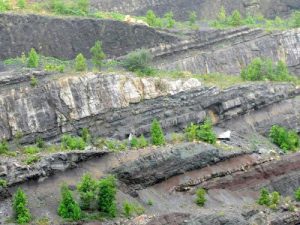Geology is a broad field with many sub disciplines that are more specialized. In order to understand what a cyclothem is, one should have a basic understanding of sedimentology and stratigraphy. Sedimentology is the study of sand, mud, silt, clay, and the different methods in which they are deposited and lithified to form sedimentary rocks. Using different methodologies, sedimentologists like Wanless apply their understanding of modern processes to ancient rock and hypothesize the factors of the formation of these rocks. Stratigraphy is the study of the relationships between rock layers and how they can shift and move. Perhaps more importantly sequence stratification is used to identify the age relationships of different rock layers. More
over, the placement of different types of strata in a stratification column can provide insight as to the global climate and associated sea levels at the time of deposition. One of the major modern applications of sedimentology is basin analysis. Petroleum companies probe these sedimentary basins to extract oil. Having a record of the formation and a detailed description of the sequence stratification of the rock layers is of primary importance to understanding where to find oil and other natural resources in these basins. Cyclothems, of course provide a concrete stratification that can be used to infer the location of different rock layers. And thus are of great importance to oil exploration.
Transgressive and Regressive Sequences
A marine transgression is a geologic event during which sea level rises relative to the land and the shoreline moves toward higher ground which results in flooding. Transgressions can be caused in two ways; by the land sinking or the ocean basins filling with water or decreasing in capacity. Transgressions and regressions may be caused by tectonic events such as orogeny (mountain building), severe climate change such as ice ages or isostatic adjustments (relative buoyancy of crust) following removal of ice or sediment load.
Transgressions can be found in sedimentary columns when there is a change from nearshore facies (where sediments are deposited) like sandstone to offshore ones, from the oldest to the youngest rocks. A regression features the opposite pattern, with offshore facies changing to nearshore ones. The strata represent regressions less clearly, as  their upper layers are often marked by an erosional unconformity. An unconformity is a gap in the geologic record. These are both idealized scenarios. In the field identifying transgression or regressions are usually more difficult. For example, a regression may be indicated by a change from carbonates to shale only, or a transgression from sandstone to shale, etc. Wanless was skilled in stratigraphy.
their upper layers are often marked by an erosional unconformity. An unconformity is a gap in the geologic record. These are both idealized scenarios. In the field identifying transgression or regressions are usually more difficult. For example, a regression may be indicated by a change from carbonates to shale only, or a transgression from sandstone to shale, etc. Wanless was skilled in stratigraphy.
The picture on the right shows a flooded foreland basin sitting in space formed when the Earth’s crust is dragged down by the weight of the Zagros Mountains.

